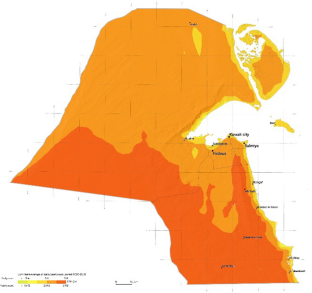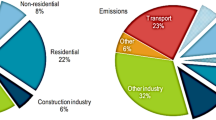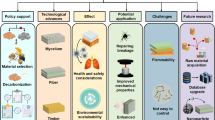Abstract
The energy consumption of buildings, particularly for space heating and cooling, is a major global concern. It accounts for a substantial portion of household energy use and varies based on environmental factors and climate conditions. Environmental factors highly influence energy-saving strategies of buildings in different climate areas. Addressing this challenge necessitates innovative approaches to building design and materials. This study aims to explore the energy performance of different walling materials in varying climates, including desert, subtropical, and tropical regions. Using transient systems simulation program multi-zone software, simulations were conducted on five room models with ten different walling materials. Notably, autoclaved aerated concrete and cellular lightweight concrete consistently demonstrated better performance in both Kuwait and Australia, resulting in reduced cooling and heating demands. The study emphasizes the significance of selecting building materials based on local climate conditions. It highlights the potential for future exploration of advanced materials like phase change materials and cool roofs. By considering local climate conditions, energy-efficient buildings can be constructed. Future research should focus on advanced materials to further enhance energy efficiency.



















Similar content being viewed by others
Abbreviations
- AAC:
-
Autoclaved aerated concrete blocks
- Bio-PCMs:
-
Bio-phase change materials
- CEPT:
-
Centre for environmental planning & technology
- CLC:
-
Cellular lightweight concrete blocks
- CO2 :
-
Carbon dioxide
- CR:
-
Cool roof
- CSB:
-
Calcium silicate blocks
- CSEB:
-
Compressed stabilised earth blocks
- E:
-
East
- EPI:
-
Energy performance index
- FAB:
-
Fly ash bricks
- FCBE:
-
Extruded moulding fired-clay bricks
- FCBH:
-
Hand-moulding fired-clay bricks
- FCBS:
-
Soft mud moulding fired-clay bricks
- GRIHA:
-
Green rating for integrated habitat assessment
- IE:
-
Infrared emissivity
- N:
-
North
- NE:
-
North-East
- NW:
-
North-West
- S:
-
South
- SAC:
-
Solar-assisted desiccant air conditioning
- SC:
-
Solid concrete blocks
- SCB:
-
Solid concrete bricks
- SE:
-
South-East
- SR:
-
Solar reflectivity
- SW:
-
South-West
- TRNSYS:
-
Transient systems simulation program
- UAE:
-
United Arab Emirates
- UV:
-
Ultra-Violet
- W:
-
West
References
Aldawi F et al (2013) A new house wall system for residential buildings. Energy Build 67:403–418
Balaji N, Mani M, Venkatarama Reddy B (2013) Thermal performance of the building walls. In: Preprints of the 1st IBPSA Italy conference Free University of Bozen-Bolzano
Balaras CA et al (2007) Solar air conditioning in Europe—an overview. Renew Sustain Energy Rev 11(2):299–314
Bruno F, Tay NHS, Belusko M (2014) Minimising energy usage for domestic cooling with off-peak PCM storage. Energy Build 76:347–353
Chen J, Poon CS (2009) Photocatalytic construction and building materials: from fundamentals to applications. Build Environ 44(9):1899–1906
Cuthbert D (2022) Beyond reason: why do people still build houses that contribute to climate change?
Daou K, Wang R, Xia Z (2006) Desiccant cooling air conditioning: a review. Renew Sustain Energy Rev 10(2):55–77
de Gracia A (2019) Dynamic building envelope with PCM for cooling purposes–proof of concept. Appl Energy 235:1245–1253
Diamanti MV et al (2013) Photocatalytic and self-cleaning activity of colored mortars containing TiO2. Constr Build Mater 46:167–174
EDILTECO (2022) Superlight aggregates for the preparation of lightweight thermal insulating mortars for screeds. [cited 22/10/2023]; Available from: https://www.edilteco.com/.
Ferrari C et al (2016) A composite cool colored tile for sloped roofs with high ’equivalent’solar reflectance. Energy Build 114:221–226
Garg N et al (2019) Initiatives to achieve energy efficiency for residential buildings in India: a review. Indoor Built Environ 28(6):731–743
Green A et al (2018) Driving increased utilisation of cool roofs on large-footprint buildings. Report
Howard B et al (2012) Spatial distribution of urban building energy consumption by end use. Energy Build 45:141–151
Karlessi T et al (2009) Development and testing of thermochromic coatings for buildings and urban structures. Sol Energy 83(4):538–551
Krarti M, Hajiah A (2011) Analysis of impact of daylight time savings on energy use of buildings in Kuwait. Energy Policy 39(5):2319–2329
METEONORM Software (2023) Worldwide irradiation data. [cited 22/10/2023]; Available from: https://meteonorm.com/en/
Meteotemplate (2023) Meteotemplate-Koppen Climate Classification. [cited 22/10/2023]; Available from: meteotemplate.com/indexDesktop.php
Nagy B, Szagri D (2018) Thermophysical behaviour of reinforced concretes. In: 6th International Conference Contemporary Achievements in Civil Engineering
Nkwetta DN, Sandercock J (2016) A state-of-the-art review of solar air-conditioning systems. Renew Sustain Energy Rev 60:1351–1366
Panayiotou GP, Kalogirou SA, Tassou SA (2016) Evaluation of the application of phase change materials (PCM) on the envelope of a typical dwelling in the Mediterranean region. Renew Energy 97:24–32
Pisello AL (2017) State of the art on the development of cool coatings for buildings and cities. Sol Energy 144:660–680
Pisello AL, Santamouris M, Cotana F (2013) Active cool roof effect: impact of cool roofs on cooling system efficiency. Adv Build Energy Res 7(2):209–221
Pisello AL et al (2016) Innovative cool roofing membrane with integrated phase change materials: experimental characterisation of morphological, thermal and optic-energy behavior. Energy Build 112:40–48
Rawal R et al (2020) Thermal performance of walling material and wall technology, Part-1. [cited 22/10/2023]; Available from: http://carbse.org/, https://www.beepindia.org/, https://www.gkspl.in/publications/
Roach P, Bruno F, Belusko M (2013) Modelling the cooling energy of night ventilation and economiser strategies on façade selection of commercial buildings. Energy Build 66:562–570
Rubel F, Kottek M (2011) Comments on:” the thermal zones of the earth” by Wladimir Köppen (1884). Meteorol Z 20(3):361
Saber HH, Maref W (2019) Energy performance of cool roofs followed by development of practical design tool. Front Energy Res 7:122
Sadati SE, Rahbar N, Kargarsharifabad H (2023) Energy assessment, economic analysis, and environmental study of an Iranian building: the effect of wall materials and climatic conditions. Sustain Energy Technol Assess 56:103093
Santamouris M (2016) Cooling the buildings–past, present and future. Energy Build 128:617–638
Santamouris M, Synnefa A, Karlessi T (2011) Using advanced cool materials in the urban built environment to mitigate heat islands and improve thermal comfort conditions. Sol Energy 85(12):3085–3102
Sedaghat A et al (2019) A new strategy for wind turbine selection using optimisation based on rated wind speed. Energy Procedia 160:582–589
Sedaghat A et al (2021a) Effects of window films in thermo-solar properties of office buildings in hot-arid climates. Front Energy Res 9:173
Sedaghat A et al (2021b) Climate change and thermo-solar patterns of office buildings with/without window films in extreme hot-arid climate of Kuwait. Sol Energy 217:354–374
Sedaghat A et al (2020a) Optimisation of capacity factors based on rated wind speeds of wind turbines. Energy Sour A Recovery Utilization Environ Effects, 1–22
Sedaghat A et al (2020b) Experimental study on the performance of solar window films in office buildings in Kuwait. J Nanoparticle Res, 22(4)
Sharma A et al (2009) Review on thermal energy storage with phase change materials and applications. Renew Sustain Energy Rev 13(2):318–345
SOLARGIS (2020) [cited 22/10/2023]; Available from: https://solargis.com/maps-and-gis-data/download
Sugrañez R et al (2013) Enhanced photocatalytic degradation of NOx gases by regulating the microstructure of mortar cement modified with titanium dioxide. Build Environ 69:55–63
Synnefa A, Santamouris M (2015) Chapter 4: Mitigating the Urban heat with cool materials for the buildings fabric. Urban Climate Mitigation Techniques
Tetali S (2011) Assessment of cool roof technology for its energy performance in buildings. Masters research study. Int Inst Inf Technol
UNDP KEO (2019) Sustaining prosperity through strategic energy management. Technical report, Kuwait Institute for Scientific Research (KISR). http://www.kisr.edu.kw/en/facilities/energy-building
Wikipedia (2012) Australia Climate Map. [cited 22/10/2023]; Available from: https://en.m.wikipedia.org/wiki/File:Australia-climate-map_MJC01_1.svg
Wikipedia (2023) Rockhampton. [cited 22/10/2023]; Available from: https://en.wikipedia.org/wiki/Rockhampton
Wikipedia. Kuwait (2022) [cited 22/10/2023]; Available from: https://en.wikipedia.org/wiki/Kuwait#cite_note-10
Wray C, Akbari H (2008) The effects of roof reflectance on air temperatures surrounding a rooftop condensing unit. Energy Build 40(1):11–28
Xie J et al (2018) Thermal performance analysis of PCM wallboards for building application based on numerical simulation. Sol Energy 162:533–540
Zhao HX, Magoulès F (2012) A review on the prediction of building energy consumption. Renew Sustain Energy Rev 16(6):3586–3592
Zheng L et al (2019) Experimental study on the thermal performance of solar air conditioning system with MEPCM cooling storage. Int J Low-Carbon Technol 14(1):83–88
Acknowledgements
This study is fully funded by the Kuwait Foundation for the Advancement of Sciences (KFAS), Australian University, Kuwait (AU) and Central Queensland University (CQU) under grant no. CN19-35EM-06, which is gratefully acknowledged.
Author information
Authors and Affiliations
Contributions
AS involved in writing-original draft preparation, conceptualization, methodology, software; SMS involved in conceptualization, writing-reviewing and editing; MIA involved in software, CAD drawings; MS involved in funding, supervision; WKH involved in software, writing-reviewing and editing; HJS involved in experiment, equipment, installation; MR involved in funding, supervision, reviewing and editing; RN involved in reviewing and editing; MMKK involved in supervision. MAM involved in data processing, data management, software. AM involved in data analysis, equipment.
Corresponding author
Ethics declarations
Conflict of interest
The authors of this manuscript have no conflict of interest.
Ethical approval
This article does not contain any studies with human participants or animals performed by any of the authors.
Additional information
Editorial responsibility: Ta Yeong Wu.
Rights and permissions
Springer Nature or its licensor (e.g. a society or other partner) holds exclusive rights to this article under a publishing agreement with the author(s) or other rightsholder(s); author self-archiving of the accepted manuscript version of this article is solely governed by the terms of such publishing agreement and applicable law.
About this article
Cite this article
Sedaghat, A., Soleimani, S.M., Al-Khiami, M.I. et al. Case studies on energy performance of walling materials in various regions. Int. J. Environ. Sci. Technol. (2024). https://doi.org/10.1007/s13762-024-05518-7
Received:
Revised:
Accepted:
Published:
DOI: https://doi.org/10.1007/s13762-024-05518-7




